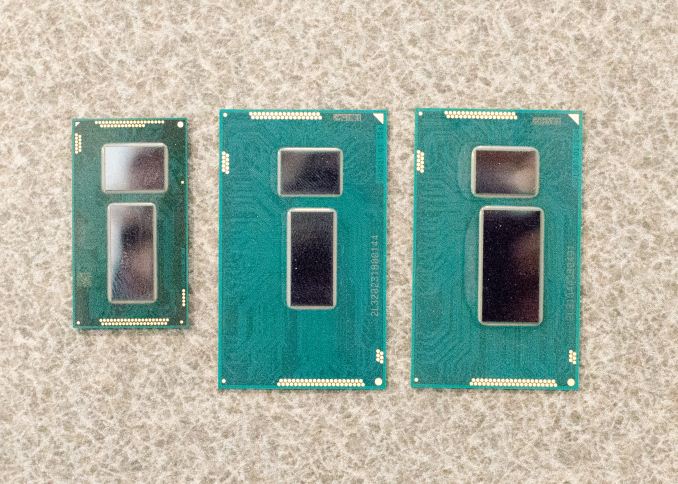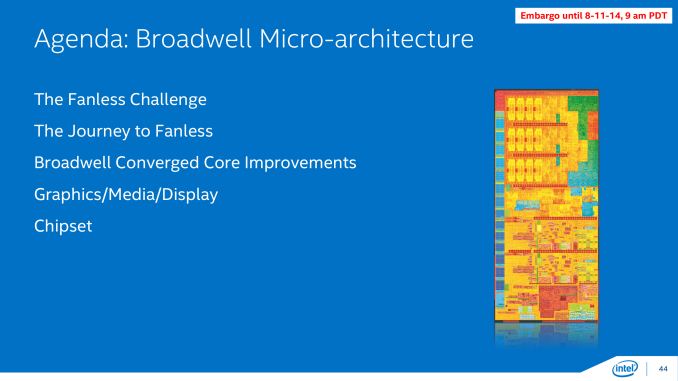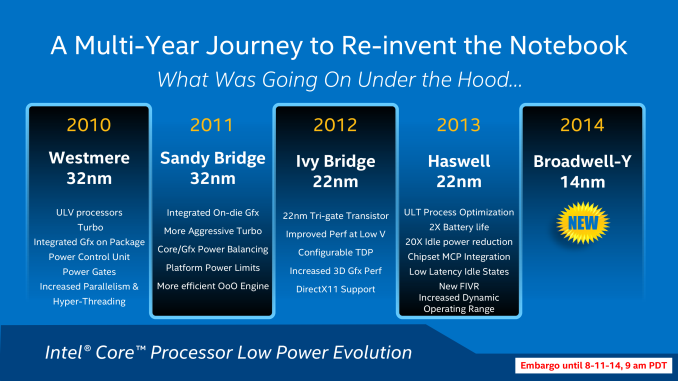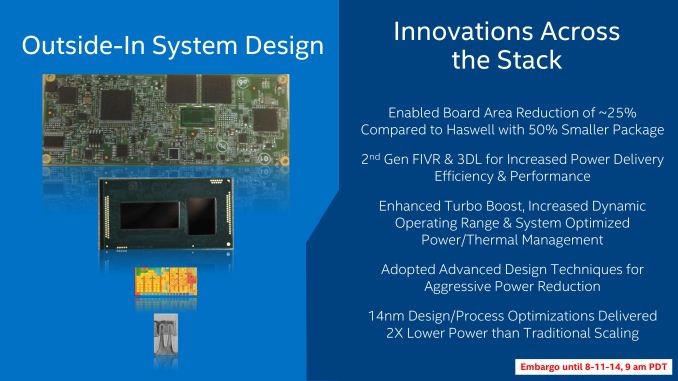Intel Broadwell Architecture Preview: A Glimpse into Core M
by Ryan Smith on August 11, 2014 12:01 PM EST
With Haswell Refresh fully behind us and 2014 now in to its second half, Intel is turning their attention to their next generation of products and processes. Intel’s tick-tock methodology coupled with the long development periods of new products means that the company has several projects in flight at any given time. So while we have seen the name Broadwell on Intel’s roadmaps for some time now, the reality of the situation is that we know relatively little about Intel’s next generation architecture and the 14nm process that it is the launch vehicle for.
Typically we would see Intel unveil the bulk of the technical details of their forthcoming products at their annual Intel Developer Forum, and with the next IDF scheduled for the week of September 9th we’ll see just that. However today Intel will be breaking from their established standards a bit by not waiting until IDF to deliver everything at once. In a presentation coinciding with today’s embargo, dubbed Advancing Moore’s Law in 2014, Intel will be offering a preview of sorts for Broadwell while detailing their 14nm process.
Today’s preview and Intel’s associated presentation are going to be based around the forthcoming Intel Core M microprocessor, using the Broadwell configuration otherwise known at Broadwell-Y. The reason for this is a culmination of several factors, and in all honesty it’s probably driven as much by investor relations as it is consumer/enthusiast relations, as Intel would like to convince consumer and investor alike that they are on the right path to take control of the mobile/tablet market through superior products, superior technology, and superior manufacturing. Hence today’s preview will be focused on the part and the market Intel feels is the most competitive and most at risk for the next cycle: the mobile market that Core M will be competing in.
To that end Intel’s preview is very much a preview; we will see bits and pieces of Broadwell’s CPU architecture, GPU architecture, and packaging, along with information about Intel’s 14nm process. However this isn’t a full architecture preview or a full process breakdown. Both of those will have to wait for Intel’s usual forum of IDF.
Diving into matters then, Core M will be launch vehicle for Broadwell and will be released for the holiday period this year. In fact Intel is already in volume production of the Broadwell-Y CPU and production units are shipping to Intel’s customers (the OEMs) to begin production and stockpiling of finished devices for the holiday launch.
Intel’s decision to initially focus Broadwell on the mobile market comes as the company takes the next step in their plan to extend into the Core processor series into these devices. Arguably, Intel has been slow to response to the rise of ARM devices, whose rapid rise has undercut traditional PC sales and quickly become the biggest threat to Intel’s processor dominance in some number of years. Intel is far from doomed right now, but even they see the potential farther down the line if they do not act.
Intel for their part has responded, but it has taken a step-by-step (multi-year) process that has seen the company progressively build smaller and less power hungry CPUs in order to fit the needs of the mobile market. Since Intel integrated their graphics on-die with Sandy Bridge in 2011, the company has continued to tweak the designs of their products, with Ivy Bridge and Haswell generation products introducing further optimizations and new manufacturing processes. Now on their latest iteration with Broadwell, the company believes they’re turning a corner and have the technology they need to be a leader in the high performance mobile market. It's important to note that despite Intel's best intentions here, Broadwell and Core M remain targeted at premium devices. You won't see these parts in cheap tablets. The duty of doing battle with ARM remains Atom's alone.
Many of these changes ultimately amount to boosting performance and reducing power consumption to a point where power and heat are where they need to be for mobile form factors, either through process efficiency improvements or through better power management and wider dynamic ranges – boosting where it matters and doing a better job of idling between tasks. However as Intel has discovered they not only need to be able to meet the TDP requirements of a tablet but they need to be able to meet the size requirements too. A particularly daunting task when the entire thickness of a device needs to be under 10mm, and the CPU thinner yet.
As a result, coupled with Core M’s performance improvements and power reductions is a strong emphasis on the size of the processor package itself and what Intel could do to reduce it. Intel calls this an outside-in system design, with various parts of Intel focusing on everything from the size of the logic board needed to hold the processor to the thickness of the processor die itself. In the following pages we’ll take a look at Intel’s efforts to get slim, but to kick things off we have a picture of Broadwell-Y from Computex 2014.

From left to right: Broadwell-Y (Core M), Broadwell ULT/ULX and Haswell ULT/ULX
Intel wants a greater foothold in the mobile market and they want it badly. And with Broadwell-Y they believe they finally have what they need to accomplish that goal.














158 Comments
View All Comments
crispbp04 - Monday, August 11, 2014 - link
Intel has something impressive in the works with Broadwell (at least on paper). I can't wait to get a Broadwell based Surface Pro. Assuming that Microsoft improves an already impressive hardware design from the sp3, the Broadwell iteration will likely be my next computer purchase.frostyfiredude - Monday, August 11, 2014 - link
I have a feeling SP4 will be fundamentally the same design as SP3 save for minor tweaks and improvements. SP3 was clearly designed for a processor with the kind of power profile Broadwell is set to deliver rather than the current Haswell profile. It will be interesting to see which set of SKUs Microsoft will put in the SP4, Core M or Broadwell ULT. Core M has a number of obvious benefits for power and area efficiency, but will it be powerful enough for their market with some features reduced from Haswell and Boradwell ULT.MonkeyPaw - Monday, August 11, 2014 - link
Pure speculation, but I think Intel might already be giving MS premium bins of Haswell for SP3, because SP3 is the only device to date to actually show off the ability to run premium Intel CPUs in a tablet format. Sure, MBA looks great, but SP3 took it to the next level.That said, I doubt that MS will use Core M in SP4, for the same reason we don't have Haswell-Y in SP3 (at least at the high end). It will probably be a step back in processing power to use one.
frostyfiredude - Tuesday, August 12, 2014 - link
Do we know what wattage the Broadwell ULT and Core M chips will be targeting? 15W TDP is clearly too high for the SP3 to handle so moving all SP4 chips to 11.5W like the current Haswell Y looks quite plausible at the moment, it just seems to be a matter of which version of Broadwell will have the 11.5W TDP.Samus - Wednesday, August 13, 2014 - link
15W is only a problem in SP3 to people who use it like a high performance computer (24x7 full load applications) but for general purpose use it barely warms up. We have people running Lightroom 8 hours a day on these things and like the Surface 2's (which I still have) they never got "hot" or "loud".That said, someone in the office infected their SP3 with some malware a few weeks ago (they literally owned the tablet not even 24 hours) and when they handed it to me, it was VERY hot with the fans whirling. Some 800kb task was using 100% of their CPU doing who knows what...at first I thought it was Cryptolocker but it turned out to be retrying a network connection. This was an i5 model, however, and it didn't seem to be throttling. The i3 will presumable run cooler, even at the same TDP.
What people need to keep in mind is these are mobile devices.
IntelUser2000 - Wednesday, August 13, 2014 - link
Broadwell ULT: 15WCore M(previously Broadwell-Y): 4.5W
vlad0 - Friday, August 15, 2014 - link
Isn't the core i3 version of the sp3 based on a Y series chip ?bebimbap - Monday, August 11, 2014 - link
agreed, Broadwell, and skylake will be vast improvements to PCs in general. Intel's Broadwell-Y announcement is all about "small, cool, efficient" while the recent FX-9590 seems more about "big, hot, gluttony" similar to the David vs Goliath story, the interesting part was the small one besting the big one. Ironically Intel is the bigger company. Hopefully AMD's new A1100 pans out as I don't want another Comcast, Microsoft, De Beers or Luxottica.wurizen - Monday, August 11, 2014 - link
well, if amd was as agressive as intel in shrinking dies or whathaveyou, then an AMD FX chip will probably be toe-to-toe to an intel i7-4930k or whatever the 6-core enthusiast intel chip is labeled. and not even die shrinks, but, also aggressive in producing a $500 cpu. imagine that. and you'd probably see an a10-7850k performance in a laptop by now. but, AMD seems content is sitting back and letting the other company do all the work, creating a path. as long as AMD doesn't completely die out, it's fine. we just need an alternative and AMD is the only one. so, go AMD. don't worry about broadwell. build it and we will come. be a niche. convert future x99 users to a future AMD product. and start from there.StevoLincolnite - Monday, August 11, 2014 - link
Except AMD can't be aggressive at shrinking dies.For one, die-shrinks costs money... For fab contracts, man-hours, research and possibly buying technology from other companies such as IBM.
AMD can't aggressively shrink dies anyway, they are at the mercy of fabrication companies like TSMC and Global Foundries, so what they can produce is limited to what they provide.
Intel has always been ahead of the industry in fabrication, the only way AMD can beat Intel is through something ground breaking (Like moving away from silicon?) or if Intel drops the ball, like they did with Netburst.
Or, AMD buys a fab company who is far ahead of Intel, which simply isn't going to happen.
Otherwise they can only compete on price and using an older more mature fabrication process allows them to do just that as the chips are much cheaper to produce, they just need to provide "Good enough" performance to mostly stay relevant, which the FX doesn't really do.